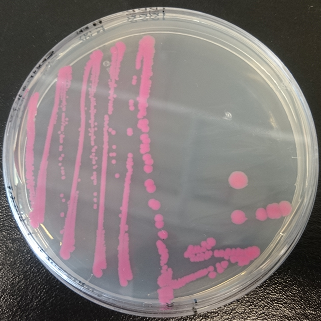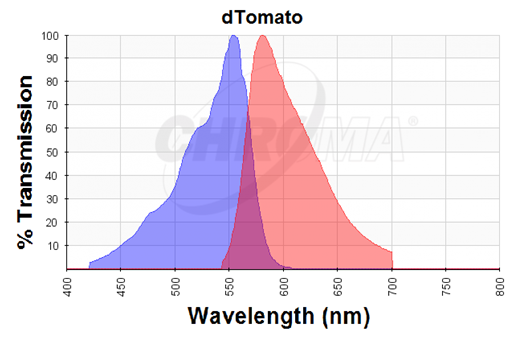Difference between revisions of "Part:BBa K1688010"
(Created page with "The dTomato protein is a fluorescent dimer protein that emits orange-red light when it is excited by green-yellow light. The excitation wavelengths and the emission wavelengths d...") |
Kandidaten (Talk | contribs) |
||
| (6 intermediate revisions by 4 users not shown) | |||
| Line 1: | Line 1: | ||
| − | The dTomato protein is a fluorescent dimer protein that emits orange-red light when it is excited by green-yellow light. | + | __NOTOC__ |
| + | <partinfo>BBa_K1688010 short</partinfo> | ||
| + | |||
| + | Assembly of Anderson promoter BBa_J23101 and RBS + dTomato (BBa_K1688004). dTomato has not been bricked previously. | ||
| + | |||
| + | <partinfo>BBa_K1688010 SequenceAndFeatures</partinfo> | ||
| + | [[File:uppsala_dtomato.jpg]] | ||
| + | |||
| + | Figure 1. dTomato expressed in ''E. coli'' DH5-alpha with an | ||
| + | inducible promoter. | ||
| + | |||
| + | |||
| + | == Usage and Biology== | ||
| + | |||
| + | The dTomato protein is a fluorescent protein dimer, created by direct evolution of the wild-type DsRed, from Discosoma sp. (Shaner et al, - Improved monomeric red, orange and yellow fluorescent proteins derived from ''Discosoma sp.'' red fluorescent protein, 2004). The dTomato protein is a fluorescent dimer protein that emits orange-red light when it is excited by green-yellow light. It is preferable to use – especially in self-made fluorometry tests – because the excitation wavelengths and the emission wavelengths don't overlap as much as in other fluorescent proteins. The dTomato excitation peak is at 554 nm and 50% of it is at 510 nm. Also, its emission peak is at 581 nm and its 50% emission at 629 nm (Figure 2). | ||
| + | |||
| + | [[File:Uppsala2015_dTomato_Chromatogram.png]] | ||
| + | Figure 2. Excitation (blue curve) and emission (red curve) spectra for the dTomato fluorescent protein (the graph is designed with the following tool: https://www.chroma.com/spectra-viewer) | ||
| + | |||
| + | == References == | ||
| + | Nathan C Shaner, Robert E Campbell, Paul A Steinbach, Ben N G Giepmans, Amy E Palmer & Roger Y Tsien. “Improved monomeric red, orange and yellow fluorescent proteins derived from Discosoma sp. red fluorescent protein”, 2004 | ||
Latest revision as of 18:07, 18 September 2015
dTomato (inc RBS, J23101 promoter)
Assembly of Anderson promoter BBa_J23101 and RBS + dTomato (BBa_K1688004). dTomato has not been bricked previously.
- 10COMPATIBLE WITH RFC[10]
- 12INCOMPATIBLE WITH RFC[12]Illegal NheI site found at 7
Illegal NheI site found at 30 - 21COMPATIBLE WITH RFC[21]
- 23COMPATIBLE WITH RFC[23]
- 25COMPATIBLE WITH RFC[25]
- 1000COMPATIBLE WITH RFC[1000]
Figure 1. dTomato expressed in E. coli DH5-alpha with an inducible promoter.
Usage and Biology
The dTomato protein is a fluorescent protein dimer, created by direct evolution of the wild-type DsRed, from Discosoma sp. (Shaner et al, - Improved monomeric red, orange and yellow fluorescent proteins derived from Discosoma sp. red fluorescent protein, 2004). The dTomato protein is a fluorescent dimer protein that emits orange-red light when it is excited by green-yellow light. It is preferable to use – especially in self-made fluorometry tests – because the excitation wavelengths and the emission wavelengths don't overlap as much as in other fluorescent proteins. The dTomato excitation peak is at 554 nm and 50% of it is at 510 nm. Also, its emission peak is at 581 nm and its 50% emission at 629 nm (Figure 2).
Figure 2. Excitation (blue curve) and emission (red curve) spectra for the dTomato fluorescent protein (the graph is designed with the following tool: https://www.chroma.com/spectra-viewer)
References
Nathan C Shaner, Robert E Campbell, Paul A Steinbach, Ben N G Giepmans, Amy E Palmer & Roger Y Tsien. “Improved monomeric red, orange and yellow fluorescent proteins derived from Discosoma sp. red fluorescent protein”, 2004


